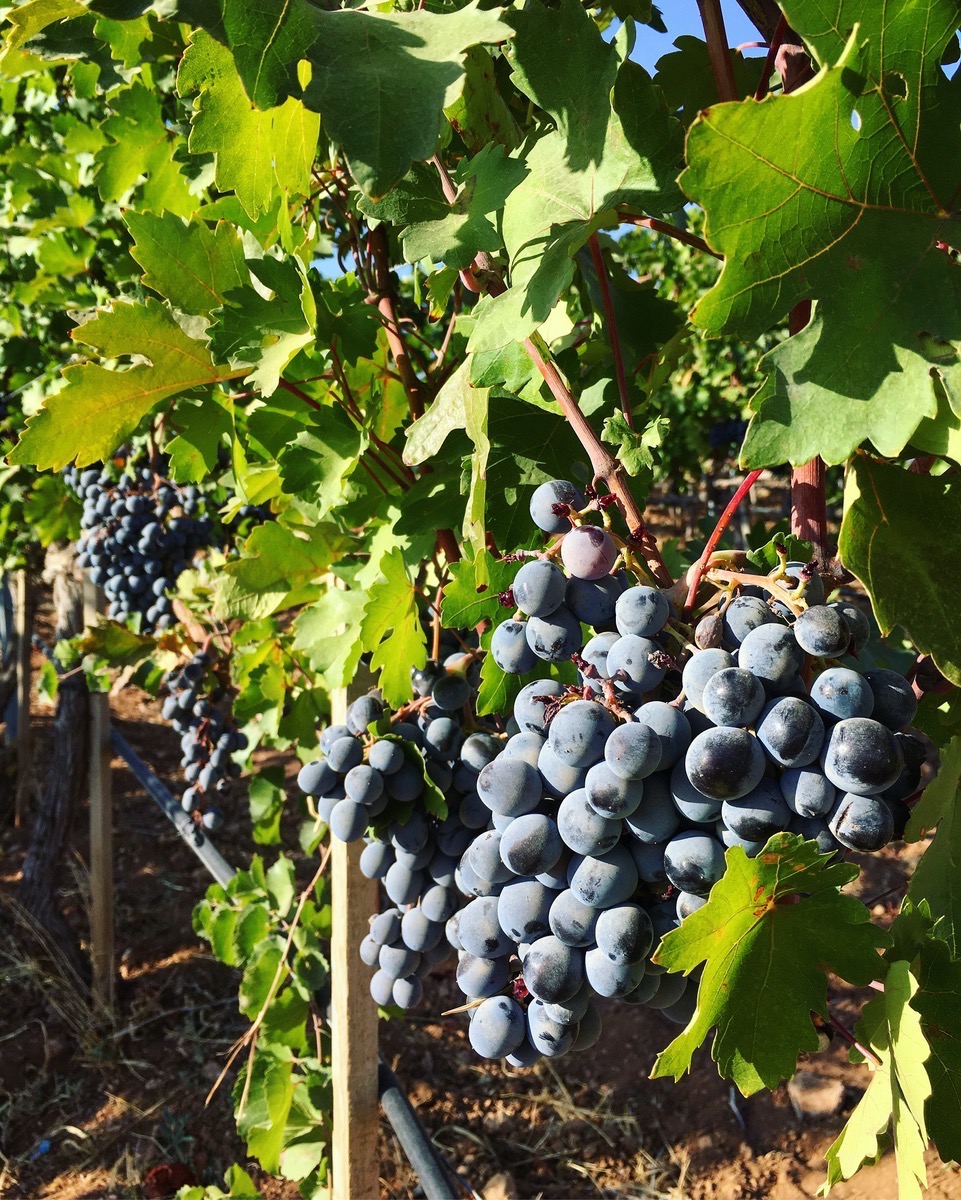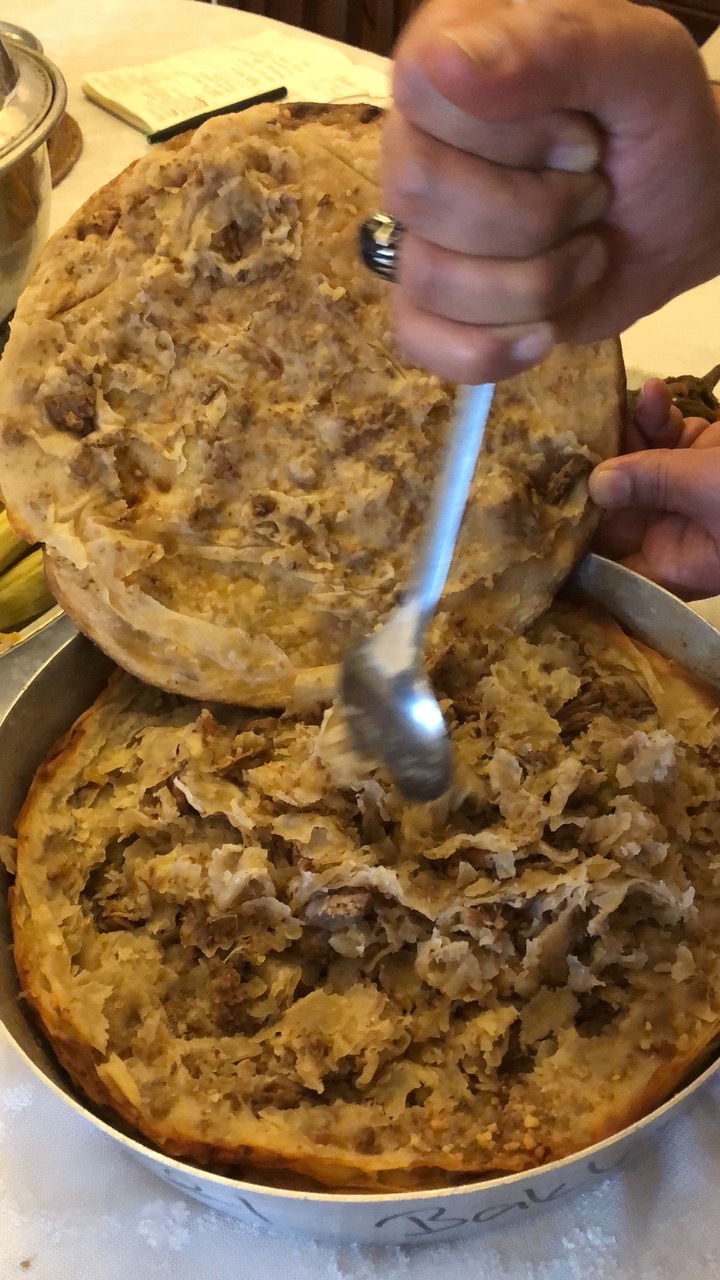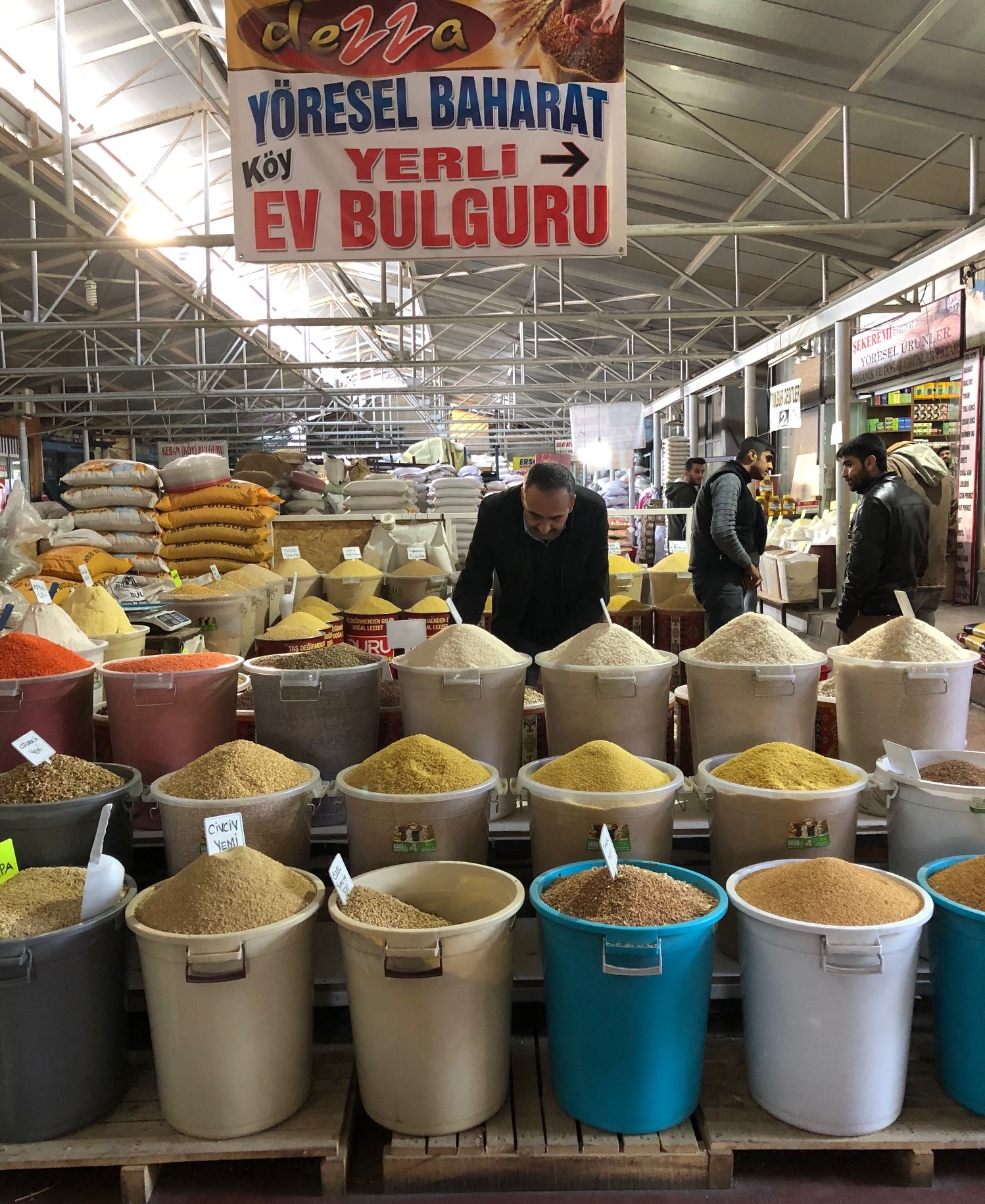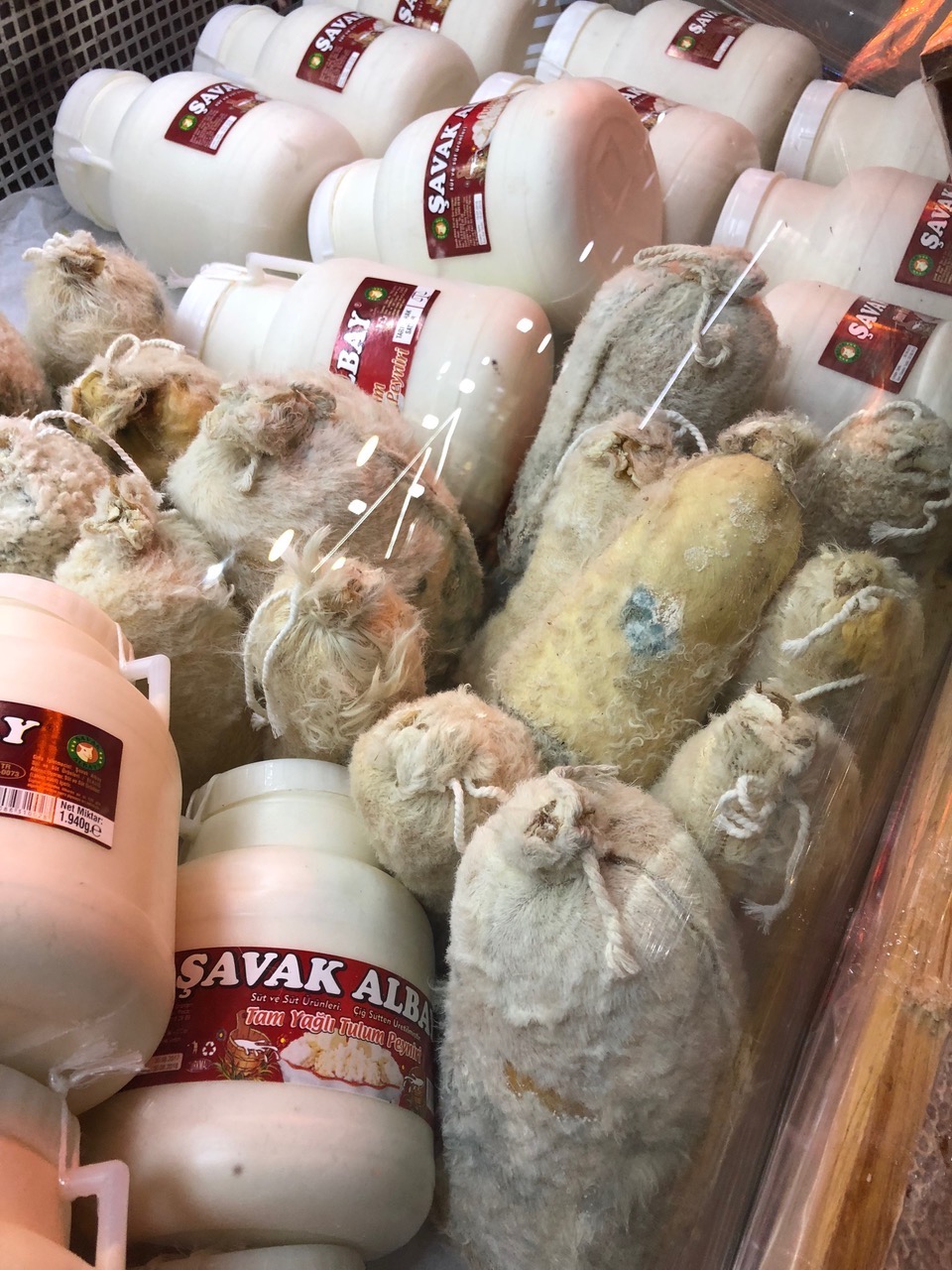
On a bright and crisp winter morning, I was greeted by the snowy mountains from afar as the plane landed to Elazığ Airport. The sun was shining above, leaving my heart and soul warm with a smile on my face…
Elazığ has been the lands of viniculture and wine production from the early times of Hittites and Urartus. This native soil has been known to hold many local grapes like Ternebi, Şifoni, Arap Üzümü, Tilki Kuyruğu, Hacı Kıran, Köhnü, Gökmani, Karamani, Hatun Parmağı, Hırsız Kesmez, Cezveni, Hasankeyf, Fengi, Yağbı, Sergen, Keşbir, Argını and more, although most do not grow anymore, lost and forgotten. But Elazığ is the home of Öküzgözü, the very grape which illuminates the future of Turkish red wines. Öküzgözü is the past, the present and the future of many traditions to follow in the wine industry.
On the same soil of Öküzgözü vines located the wine factory of Kayra, where 14 different wines are produced from Öküzgözü and Boğazkere -also indigenous red grape originated from Diyarbakır-, especially known as the home of their famous wine Buzbağ since 1944, the year which the factory was founded.
As once the great traveler Evliya Çelebi mentioned in his famous travelogue Seyahatname, the grape of the city is famous, the bakeries and bread are of great delicacy. Though the variety of the grape is unknown to us, it is possible that he was talking about Öküzgözü.
Öküzgözü, other than winemaking, is mostly consumed as molasses and molasses based sweets in Elazığ. Still, most of the Orthodox households make their own house wines with Öküzgözü but apart from them, wine is not a preferred beverage nor a part of Elazığ daily life.
Though Elazığ inhabitants are conservative, the history holds all the religions together in these native lands; Armenians, Syriac Christians, Orthodox, Muslims. The cuisine of the city is not divided by the religious beliefs, the dishes hold the same names at all households, but surely you come across some minor ingredient differences.
But when it comes to food they all talk the same language, the language of feeding their loved ones and the best meals are always cooked and savored at homes and the housewives are masterful cooks.
If you are lucky enough, you’ll get to dine at a local’s house, witnessing the daily lives of that beautiful family.
A home-cooked meal in Elazığ…
As Şeyda Hanım rushed outside the house to greet us, the scent of the food she has been cooking, followed her. From the kitchen doorway, at a glimpse, you can see the small kitchen table full of service plates stacked on top of each other, utensils and bread, lots of bread. It always made me wonder, how this amount of food, this amazing food is cooked at those tiny kitchens.
We were at Şeyda Şedele’s home and in the kitchen with her Neşe Süzen and Burhan Özdemir whom I call the goodwill ambassador of Elazığ, taking us around and arranging a home-cooked meal for me and Emre Ademoğlu, one of the two winemakers of Kayra in Elazığ.
She invited us all in the big living room where the dinner table was set, as one dish followed the other, Şeyda Hanım kept disappearing in the hallway and returning with her hands full.
Mugaşerli köfte, mugaser – muğaşeris split chickpeas without the skin, made from the local black chickpea, used widely in cooking. Bulgur, flour, onion, and purple basil is kneaded then made into mini small patties like orecchiette, then boiled and topped with, clarified butter and mugaşer. Muğaşer is added to erişte çorbası-noodle soup- or bulgur pilavı as well as many other dishes.
Hamur sarması, a thin layer of dough is stuffed with roasted, ground local sesame seeds, called küncü, onion and mincemeat sautéed and rolled then boiled, finished with melted butter. Simple and appetizing, I could not take my hand of it.
İçli köfte, mincemeat stuffed bulgur balls, mincemeat mixture is onions, black pepper, mincemeat, tomato paste as Neşe Hanım explains, Şeyda Hanım’s spices differ, she adds cinnamon and allspice omitting the tomato paste. Boiled, served and eaten when hot and flavourful.
Gömme börek, the buried börek, a hand-rolled dough pastry forming in layers on top each other. The top and bottom layers are thicker than the ones in the middle, the stuffing is kavurma, küncü and walnuts. Before serving it, you lift up the thick top layer and with a spoon, you crumble and tear the yufka layers inside, which later served with the help of a spoon. It is cooked in between two fires, on top placed a tray and on top with ember, why it is called buried börek.
Bumbar, the thinnest I have seen specially made for the guests, is from a young cattle, intestines stuffed with rice, spice and drizzled with cumin sprinkled melted butter, Şeyda Hanım’s face lit up when she tasted one. The cumin is so complementing to the earthiness of the dish.
İç pilavlı kaburga dolması, the rib cage of the cattle stuffed with rice, almonds, spice, liver, cooked in its juices till it falls off the bone and the rice cooked to perfection. An exquisite dish, still cooked as a celebratory food at weddings or such in Elazığ.
Bulgurlu köfte, a very simple bulgur ball easy to prepare, as called terbiyesiz köfte
-impudent meatball- amongst locals, used to prepared by the housewives who spent their days out entertaining with friends till night falls and did have time to prepare a worthy meal to their husbands, so they prepare this easily made köfteand serve to their husbands at dinner.
Patlıcan salamura, small eggplants, stuffed with tomatoes, Arnavut biberi– a small green chili- garlic, then this mixture is stuffed in the parboiled eggplants and they are tied with sprigs of parsley. Pressed into the earthenware pots, and topped with grated tomatoes and let to ferment. Like a brined pickle, spicy, bold and addictive.
Turşu, pickles, are consumed immensely, every household makes their pickles. Especially kesirik lahanası, a local white cabbage, is famous and a piece of sourdough is added for fermentation during pickling.
Taş ekmeği or sıvıtmalike a crêpe, eaten as dessert, as Şeyda Hanım’s mother used to explain in the old days as this sıvıtmahas originated from France, well it is crêpe, but finished with a generous amount of grape molasses. The best of both worlds.
Güveç, dizme, bulgur pilavı, mercimek köfte, erişte pilavı, salamura, döğme çorbası, kavurma, üfeleme, dilim dolma, lovik, dolanger, zerde, anamaşı, kellocoş, ışkınlı yumurta, kofik dolması, Harput köftesi, patila, su böreği, how can one describe all of the city’s 150 different dishes…
The city’s cuisine’s main staples are bulgur, meat and dough-based dishes, the common spice used are purple basil, black pepper, salt, parsley… It is better to visit Elazığ once a while in different seasons to savor the tastes and the long dinner table conversations…
Although we did not have wine to celebrate this beautiful lunch, the table in my mind had plenty. I was having a glass of Kayra Öküzgözü with hamur sarması, that sesame paste and the silkiness of the dough so complimenting.
The dishes served, bulgurlu köfte, bumbar, içli köfte, meaty, fatty and characteristic, shouting out to be paired with again Öküzgözü grape, especially from Alpagut vine, a single vineyard bottled as Kayra Versus Alpagut Öküzgözü. Perfect with red meat, bulgur, onion, and tomato-based dishes, balancing them with its generous acidity.
A bottle of Buzbağ, for me, is one of the key elements that should be cherished with the characteristic cuisine of Elazığ, the very wine that has been produced from 1944 yet being perfected by the winemakers of Kayra, each and every year. The typical Anatolian cuisine, forming of meat and wheat, meeting with the indigenous grape of the land, as we should say whatever grows together, goes together, inseparable.
If I was having this lunch at the priest’s home, I am sure Dr. İzhak Tanoğlu, would serve me a glass of his homemade wine, which he learned from generations of experience, the winemaking of Armenians is the legacy of these lands.
During our long lunch, she was always persistent that we should taste this or that, sit down, eat more, taste all, and start again. A habit we all are very accustomed to in Turkey, where the women of the house feed you till you burst or else.
The memories kept pouring, a remembrance, a peal of laughter, a silence, a lot talk, sweet sweet talk…
The courses of the day…
Unfortunately, if you like to sample the city’s local cuisine, you have to be a guest at a local’s home. The city has many dining options but none of them consist of local dishes, just kebabs. Tencere yemeği as they call the home-cooked dishes are eaten at homes whereas kebabs are always eaten outside.
Esnaf, the small tradesmen in Elazığ, the shop owners, love to have a hearty breakfast at home then leave for work. Lunch is kebabs around the office, later returning home for a home-cooked meal.
Breakfast, the first course of the day is as plenty as any other meal. Roasted vegetables in the neighborhood oven, kinds of böreklike patila-a thin hand-rolled dough filled with different ingredients like mincemeat and onions, potatoes or cheese, and folded like a square and cooked or another kind of hand-rolled börek is a must breakfast item, as well as fried liver.
Şeyda Hanım adds that they do not eat only cheese and olives, they are like snacks to us. As she was talking, she invites us to breakfast for the next morning, I glare at the table full of uneaten dishes and sigh…
After dinner follows another ritual, as Elazığlılar like spending their nights at home, having dinner with their families, the dinners followed by the snacks, a wide variety of dried fruits, nuts and orcik. They even have a verb for it, yatsılık çıkartmak– getting out the snacks after dinner.
The tranquil streets at night tell it all.
From grape to sweets; Orcik and Pestil
The most fun time to visit Elazığ, for me is after the grape harvest when grape turns into many things magical like wine, pekmez, orcik, pestil.
Grape is pressed and then the juice is simmered for hours and reduced to a thick consistency. That is called the molasses, pekmez. Not only grape but also white mulberry molasses is used in Elazığ too.
Starch is added to the molasses and stirred, after thickened, a string full of walnuts are dipped into the starch molasses mixture and hang to be dried. This process is repeated 3 or four times. This laborious sweet is called orcik, loved and consumed by all during cold winter months. Elazığlılar, start eating this boosting sweet for energy starting from the first snowy day, not before.
Orcik can be made from different molasses. The amber colored one is the white grape molasses made from Şifoni grape, the dark brown one is slightly sour, giving out the characteristic taste of Öküzgözü grape. The lighter colored ones, which sometimes preferred by the tourists might be made from corn syrup or white mulberry molasses.
Pestil is fruit leather, can be made from pulpy fruits and molasses, spreading the molasses or the fruit purée an even thin layer on the tea towel and leaving it to dry under the sun. Here, pestil is also made from Öküzgözü and other grapes, mulberry.
Winter preparations in Elazığ
Middle Anatolian cities have harsh and long winters, the soil is covered with snow for months, so be prepared for a tasty and healthy winter is mandatory and customary. Winter preparations start during summer months, last till the end of autumn, when there is plenty of sun, vegetables, fruits and they are at their best.
Some of the main items are;
Bulgur-the boiled, dried and ground wheat berry in different coarse-, erişteand şehriye-noodles, and thin vermicelli-, tandır ekmeği -tandoori bread, orcik and pestil– walnuts on a string dipped in the grape molasses and starch mixture and dried, pestil is fruit leather, made from different fruits in Elağız mostly from Öküzgözü grape and white mulberry, apricot and plums. Tarhana-dried fermented yogurt and wheat berry, vegetables soup, like an instant soup, pekmez – molasses of both grape and mulberry, turşu– pickles, gurut – dried ricotta cheese, peynir,Şavak tulumu, cheese making, kavurma, sucuk– confit of meat and sausage making, kofik -dried vegetables-, kuru meyve dried fruits like grapes, apricots, mulberries, winter grape, winter pear and winter melon, which are hang at the cellars in houses, and consumed in winter months.
One of the main soup varieties in Elazığ is tarhana, has its own recipe like the other cities, simply whatever grows in your soil, you make the tarhana with those. Generally, the ingredients are sourdough, yogurt, wheat-berry, sugar beet’s green leaves, red pepper, beyaz biber-the local spicy pepper of Elazığ-, mint, it takes a couple of weeks to prepare, the paste then rolled like a cylinder ball and dried under the sun. You enjoy this hearty soup, especially in winter months.
Çarşı Pazar Elazığ; the food market in the city
Elazığlılar protect their culture, food, history as well as the shopping habits cause there are many markets serve the need of the locals in the city center.
Çarşı, the market area of the city, is named after the food groups sold in each specific area.
Şire Meydanı, the square where you may find all kinds of molasses based sweets.
Buğday Meydanı -the wheat market-, a market for grains, pulses and a mill to grind any flour of your choice.
Kadayıf Pazarı -kadayıf bazaar- kadayıf; the angel hair pasta made into many different sweets, is now a small street in the main closed market Kapalı Çarşı-the closed roof market- which happens to be the home of the fishmongers and the butchers, dried nut and dried fruit shops – kuruyemişçiler– making this venue as vivid as possible, also is the most visited market area in Elazığ.
Peynirciler Çarşısı– the cheese market.
Bit Pazarı-flea market- where used to be antique shops now turned in to the one dollar kind of shops.
Bakırcılar Sokağı-the coppersmith street- which unfortunately left with only a couple stores selling huge cauldrons used for making molasses, cheese or bulgur and other copper utensils.
Only one storefront is open at the Leblebiciler Market –the roasted chickpeas-, Ağın leblebisi – the roasted chickpea named after the village where it is made– one of the main staples to snack during winter months, made from a local chickpea called tüylü nohut, woolly skinned chickpea.
Weekly neighborhood open-air food and vegetable markets, pazar, also serve to the needs of the households living in the same area. If you do not want to go to the city center for grocery shopping, the produce comes to your way, once a week, so all they do is filling up the kitchen with vegetables and fruits last for a week.
Kasaplar, the butchers play a different role in the city’s cuisine, beyond serving you the cut of meat of your preference. If you are having guests over, you call your butcher, tell him the number of guests and he prepares a tray full of meat and vegetables, tepsi güveci, and take it to the neighborhood bakery. From there you take your wood burning oven baked casserole, and piping hot bread to your order and serve it to your guests.
Fırınlar, the bakeries have another compelling and delicious story. Bread, which is the main staple, is so delicious in Elazığ, you really do not need any cookies or cakes. And if you spend a slightly long time in any bakery, it is possible you will be left with your hands and your stomach full. Some of the varieties of açık ekmek –the flatbread is named after the shapes- is tırnak pide, baklava dilimi, which all are flatbread, thicker thentandır ekmeği those little puffy squares on the bread or the diamond shapes defines the names, fodula, like round sandwich bread enjoyed with butter when came right out of the oven, nohut ekmeği, chickpea bread, cornbread, mercimek ekmeği, lentil bread, made from the lentil flour and vegetables, bazlama, is a yeast bread cooked on a sac, a concave tray placed on the fire, and the one without the yeast is called fetir. Pağaçis another one baked at the flour mills, just mixing the flour with water and putting the bread on ember, is the quickest easiest way may be for the miller himself… Not to forget the sugar sprinkled cheese pide.
Also, lahmacun is prepared at the bakeries, the mincemeat mixture is taken to the bakery and the baker top them on the thin flat dough and bake them for you. Lahmacun is one of the dishes that are sent to the home of the departed as well.
Not only casseroles but the vegetables that are eaten at breakfast also sent to the bakeries to be roasted. You see small children or the young ones with a tray in their hands heading to the bakeries early in the morning especially on summer months, sebze tepsisi, a tray full of vegetables like eggplant, onion, potatoes, pepper…
I left Elazığ, my bag full of tarhana, orcik and Şavak tulumu, my palate longing for all the food that I could not finish at Şeyda Hanım’s home… Next time!









